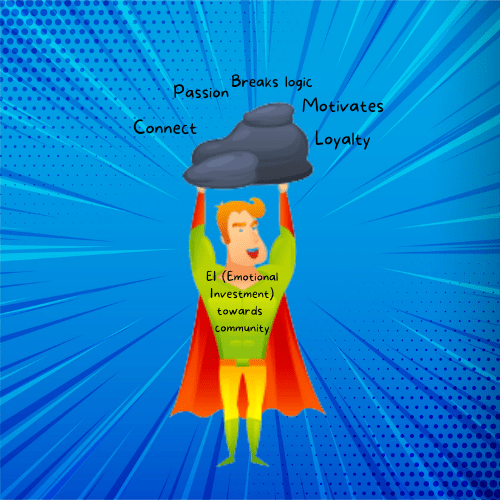Community & Cold Coffee Ep- 8 🥤😎| How emotional investment is vital for the first 50 members in the community?

The first 50 members in your community play a vital role; they are the ones who determine the future of your community. All communities have a purpose and goal, but it all lies in how the first set of members perceives or interprets it. They set the tone and culture of the community. And this step is inevitable for any community.
Having this in mind, the chat took its efforts to discuss who they can be? What is that one factor or the first factor you would look into in your community’s members? How to treat them?
Malavikka - Your members choose you, for which you need not envision your purpose alone, but you need to tell your members what you are going to do for them. People who match your purpose and contribute towards organic growth should be the first 50 members.
Amit Pandey - When you share your story and how your community will be, people who love the idea will eventually come to you. Share your vision board with its value proportion- members will join in naturally.
Prakarsh - It’s not possible for the members to envision in the same way what you have in mind. So that is where educating your vision to your members becomes crucial. The first 50 members are the super users of your community, and they mostly fall into the ratio of 90:9:1. And these first 50 members create a way for you to learn out of it.
Deepak - All communities should have a balance between high and low, people who love to read and people who love to write, people who are in favor, and people who have a remark. At some point, we realize these differences are beautiful and start admiring them.
EI- Emotional Investment glues a member to their community
This week’s C3 brought out a remarkable aspect that can turn a community upside down, EI (emotional investment)
What is an emotional investment (EI)?
EI has different definitions. But what it means is that when a person likes someone or something, no matter what; then he has emotionally invested in that person or thing.
The chat slowly led its way to the core aspect that glues a community. To be honest, it glues the entire world. The emotional investment people put in on others makes people go back to them, people may call it likability, fan base, loyalty, love, no matter what people call it, deep down the cause for all these reactions is the emotional investment people put in, and Deepak and Varu beautifully put it, how it determines a community.
@Deepak - Emotion investment is crucial because this can break logical reasoning. If a person likes something, no matter how it is or what it does, he or she will still love it; this emotional investment makes a community successful.
@Varu - All communities have a purpose, but how the members take it is how the community will be. So, if the members act in these two ways, 1. Staying motivated to contribute to the community, 2. Set the right tone and culture for the community. Then the community will be successful.
As Varu and Deepak emphasize the importance of emotional investment needed in a community, especially in its initial stage. Malavikka raised a question: Why emotional investment and not interest?
EI ≠ Interest
Emotional investment
Stronger bond
Breaks logic
Passion is an emotion, and only that makes a person do something, even if he gets nothing out of it.
Interest
Interest can bring a person to a community, but an emotional investment makes him stay connected to the community.
This whole idea made so much sense and was appropriate to be the factor looked into by the first set of community members. This understanding created the need to understand another difference which is easily mistaken in a community scenario.
Groups ≠ communities
Understanding the difference between groups and communities will help you know what to expect out of a community
GROUPS | COMMUNITY |
Group of experts | Gathering of people with the same interests |
People tend to share what the other person already knows | A wide range of different perspectives come into the picture |
Common content | Rich content |
There might not be an emotion | There is a strong emotional connect |
The saturation point has been achieved | Has numerous ways to help improve |
People here want to express | People here want to learn |
The experience is not that joyful | The experience is amazing and valuable |
This complete walkthrough by Sudarshan of these two aspects was an eye-opener for community managers to understand the difference and work accordingly. This whole idea again puts out that emotion is the one aspect that differentiates a community from a group, and a community has it.
Now that emotional investment has to be the core, other things along with it can help a community, and they can be the Personas and characteristics of members. This can take the community a long way, so what should the persona or characters of the first 50 members be?
Deepak- I believe that whatever the persona is, the community becomes valuable when a person brings their complete self to the community. That is when the differences among them bring value. Everybody, there is going to have something in common, and talking about that common thing won’t bring out their difference in that identical crowd.
How to use the first set of members as the torchbearers to set the tone and culture of your community?
Do not set rules, but set guidelines. Build a community for the people and with the people.
Set an environment that encourages people to bring their wholesome persona by setting offbeat days.
Now that people added all these ideas, that’s when Prakrash made an interesting statement asking, how could all this be measured on a virtual platform? How to calculate the ROI of a community on this basis?
These can be the metrics that can indicate ROI
New member joining
Old members retained
Natural transit of loyalty of the customers towards the community
When support works successfully, it will cut down a huge chunk of investment made in other support forms. Now that’s a positive ROI.
A community does the job of a campaign, but it’s not deliberate or with high investment. It’s natural.
The gratitude of the members.
That’s when Varu made things easier by explaining the entire process in a diluted way with an example. So here is how a community contributes to ROI.
Imagine a support community. Their primary aim is to resolve customer problems. A member puts out a problem, seeking a solution, another community member comes forward and puts a suggestion and helps. Now that the problem is solved, member comes in and shows gratitude. Both people involved feel positive, and the connection grows.
From the customer: A brand saves a customer that can churn and at the same time gain their trust and loyalty.
For the brand: In the absence of a community, the brand to achieve this has to spend on 3 aspects:
Money - A brand has to put in place a customer care calling system that involves a sum of money.
Human resource - A brand has to pay for one or more people who can do the job of conversing with customers, solving their queries.
Time - A customer expects an immediate solution, and that has not been possible with a customer service number and imagine a person has to talk to a client for 5 mins and if he has to take 50 calls per day, that’s a huge amount of time a person and a brand has to put in.
When a brand chooses a community, they tend to save a ton of money and time which is spent on the service, human resources, physical resources, etc. This can cut so many expenses and make sure the customer doesn’t churn. All these aspects result in a better ROI. If ROI is what you want? Here is it, in a community.
Now that people in the call were enlightened about the ROI in a community, they wanted to find ways that would help in expanding the growth of their community.
How to expand?
The community itself will ask for it. Once you put enriching content and people converse on it, the community themself will want a difference of perspective in the community. They will invite members or will start asking the community members to do so.
The community has to be created by emotion. When done right, people will bring people.
A feedback lost = A Dollar lost - A community that has a set of people who give remarks will motivate the community to do better and this increases brand loyalty and a customer will be happy to come back to you again. Taking in feedback will result in successful sales.
Takeaways
EI is what that has to be in the first 50 members of a community
EI ≠ Interest
Groups ≠ Community
Your ROI can be achieved by your community
You would know by now, this episode has been super insightful. This chat ended on a fun note with everyone happy with what they could contribute and learn. After all, that is what communities are all about.


 Habitate
Habitate